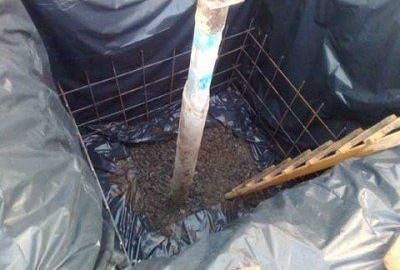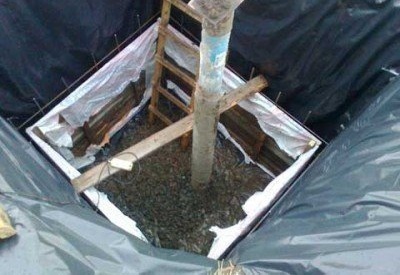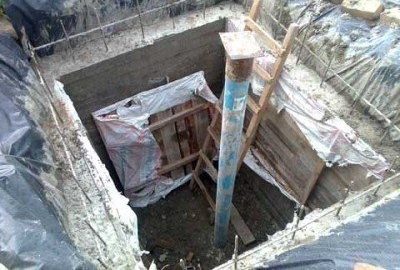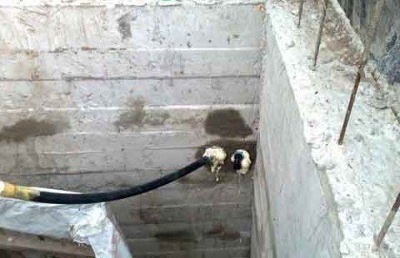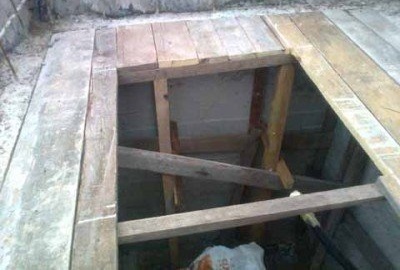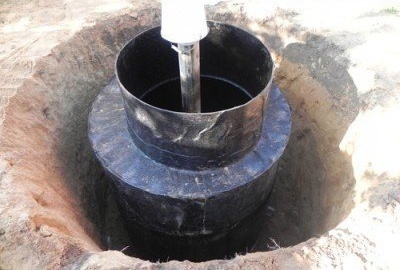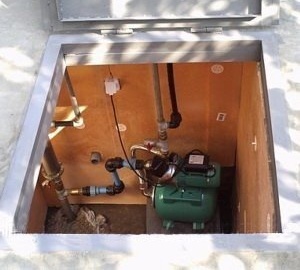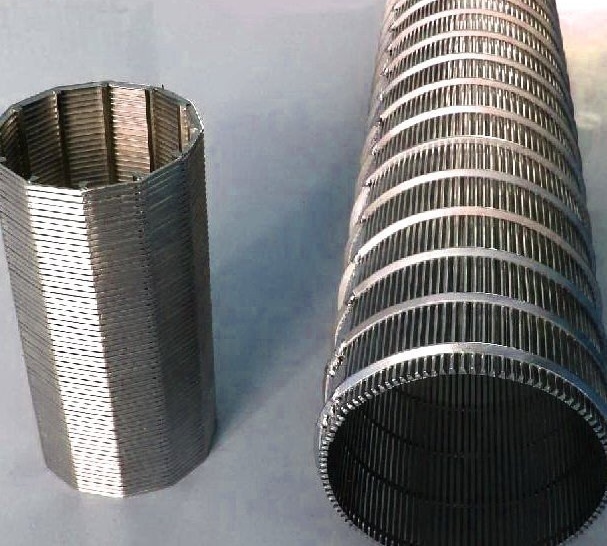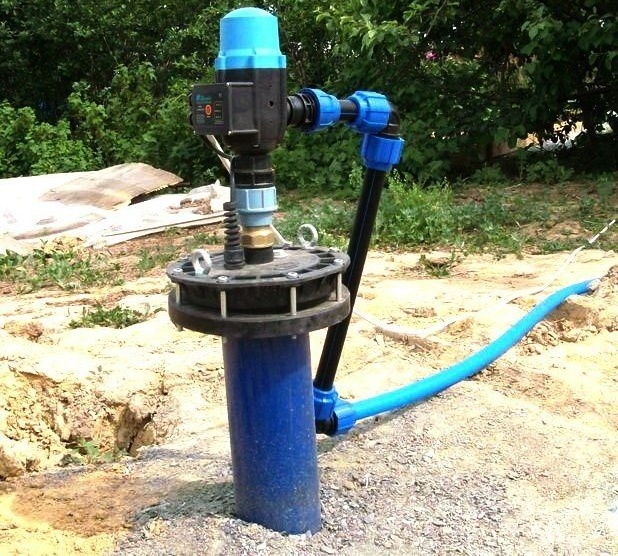How to make a caisson for a well with your own hands: the construction of concrete and metal structures
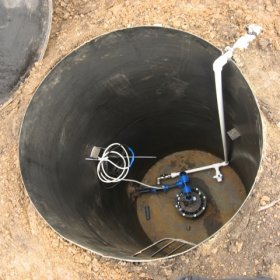
Each owner of a well just drilled knows that the work on arranging autonomous water supply is still very far from completion and will require serious financial costs and efforts. And if you want to save at least a little, you should try to assemble and install a caisson for the well yourself. To do this, you do not need to be left-handed from a fairy tale, it is enough to have an idea of construction work.
Content
The device of the caisson and the types of these structures
Most owners intend to use the well year-round. However, few people boast a small annual temperature difference. Most often, heat awaits us in summer, and in winter - severe frost. It is possible to operate a well in such conditions, but with certain limitations. Water entering the surface at freezing temperatures will freeze and tear or ruin equipment.
Therefore, the owner of the well must first ensure stable positive temperatures for the head of the structure. To do this is quite simple by installing a caisson.
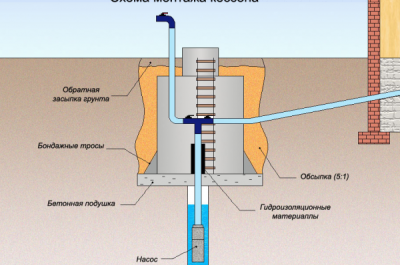
It doesn’t matter what material the structure will be made of, the design of a well caisson means protecting the equipment from the adverse effects of low temperatures and from flooding it with flood waters or heavy rainfall. Some types of containers can be made by yourself.
The sealed container in which the equipment is placed will not allow it to freeze in the most severe colds. The shape of the caisson can be any, and the sizes are chosen so that there is enough space for all the devices, and a person could go down there to service them. Capacities can be made of:
- Plastic. A practical option, characterized by excellent sealing and ease of installation. The insufficient rigidity of the material can be compensated by pouring the installed capacity along the contour with concrete.
- Concrete. Durable design with a fairly complicated installation. Requires additional hydro and thermal insulation.
- Bricks. Good performance and difficult installation.
- Metal. Sufficiently strong and durable option. The material from which the caisson is made is susceptible to corrosion, so additional waterproofing will be required.
We independently construct a concrete caisson
Before starting work, you need to decide if a sealed container is needed or not. The first option is chosen in the case of a high level of groundwater, and in this case, a concrete floor must be equipped, in the second one you can do without it, sprinkling the bottom with gravel.It is also necessary to find out the dimensions of the future structure. If the equipment for the well will be indoors, the minimum size of the caisson is 1x1x1 m, if in the tank it is 1.5x1.5 m high about 1.8 m high.
The process of constructing a concrete caisson takes place in several stages. Let's take a closer look.
Arrangement of foundation pit for construction
Around the casing, a hole of the right size is dug. Crushed stone is poured onto the bottom with a layer of about 15 cm. Before starting work, the walls of the pit are best covered with a foundation film, which will protect the structure from groundwater.
Mounting mesh reinforcement
Retreating from the walls of the pit about 7-8 cm, a mesh of reinforcement is knitted. Its height depends on the size of the future structure. It is best to fill the entire structure as a whole, but this is far from always possible, and then the installation of a caisson for a well is divided into several stages. Accordingly, on the first one, a series of fittings of the required height is set in steps of approximately 30x30 cm
Installation of formwork + casting
The formwork can be assembled from old bars and boards. Experts advise wrapping it with a building stapler with plastic wrap. So it will be much easier to remove the structure from the hardened concrete. After installing the formwork, concrete is poured. If concreting is carried out in stages, then after the "setting" of the material, it is assumed that the assembly of the reinforcement, the installation of formwork and pouring is repeated until the design of the desired height is obtained.
After the structure has completely dried up, holes are made in the walls of the caisson with a perforator to bring the necessary water pipes. At the passage through the concrete, metal sleeves are put on the parts.
The gap between the sleeve and the pipe is sealed with foam, between the concrete and the sleeve with mortar.
Lid formwork
The design is a wooden shield laid on the bars. Durable material is taken for its construction. About six bars are vertically exposed on the boards, and more bars are stacked horizontally on top. Everything is twisted with self-tapping screws. Formwork boards are attached to the resulting base. The design should include a hole for the hatch, on which a wooden box of the required size is installed. The resulting structure before pouring still needs to be reinforced with bars below.
When thinking about how to make a caisson for a well with a stronger cover, you can choose the option to strengthen the structure by letting the reinforcement run along the perimeter with a step of 5x5. The rest can be knitted in steps of about 15x15. If necessary, metal fittings for ventilation and a watering hose are fixed to the fittings of the future cover.
Concrete filling
The structure is poured with concrete. The hatch is fixed.
Concrete caisson is ready. If necessary, its walls can be treated with a waterproofing composition, since concrete is very hygroscopic, and insulated. In a similar way, you can arrange a brick caisson. Only in this case, brickwork is used for the construction of walls.
Assembly and installation of metal construction
A traditional metal caisson for a well is one of the most popular solutions. This is explained by the fact that such a structure is quite easy to assemble independently. You only need a sufficient amount of metal, 4-5 mm thick and a welding machine. Such containers are made in the form of a parallelepiped, a cube or a cylinder.The latter option is the easiest to manufacture. When choosing the shape of the caisson, it should be borne in mind that the number of welds directly affects the service life of the structure. The fewer of them, the correspondingly smaller the number of potentially hazardous areas for corrosion.
In the bottom of any shape of the tank, an opening for the casing is necessarily made, somewhat larger than its diameter. A sleeve is welded to the hole, which should be easy to put on the casing. Nipples for water pipes are welded into the walls. At the top of the structure there should be a hatch through which you can go down inside.
These are all the design features of the caisson. The inner surface of the container must be primed, and the outer - coated with several layers of bitumen mastic to protect against corrosion.
Installation of the structure is quite simple. A caisson is installed on bars over the prepared foundation pit. The sleeve is put on the casing and, removing the props, carefully lower the structure down. Then the caisson, which has risen to the bottom of the pit, is leveled. Pipes are inserted into the container through the prepared nipples, equipment is installed. Practice shows that it is better to insulate the upper part of the metal caisson and make another one insulated over the metal hatch.
Thus, self-installation of a caisson for a well is quite possible. Of course, this is quite a responsible and troublesome business, but you can handle it if you wish. Do-it-yourself designs will last for many years, ensuring an uninterrupted flow of water from the well at the site.
